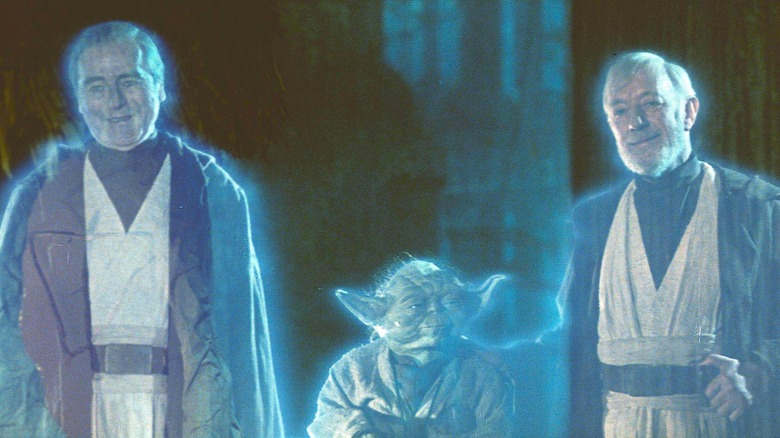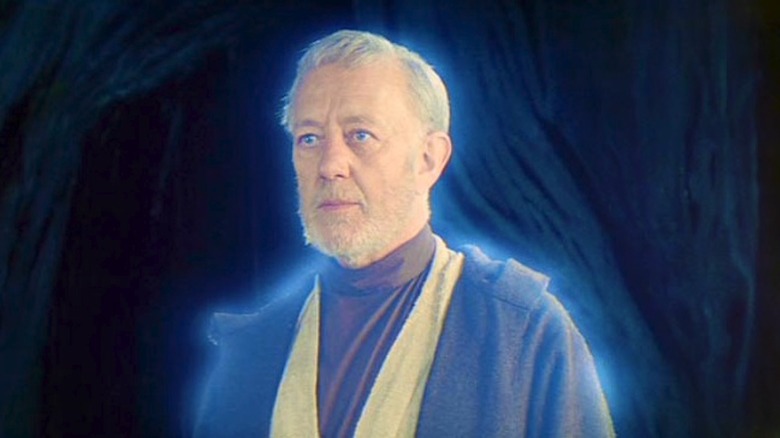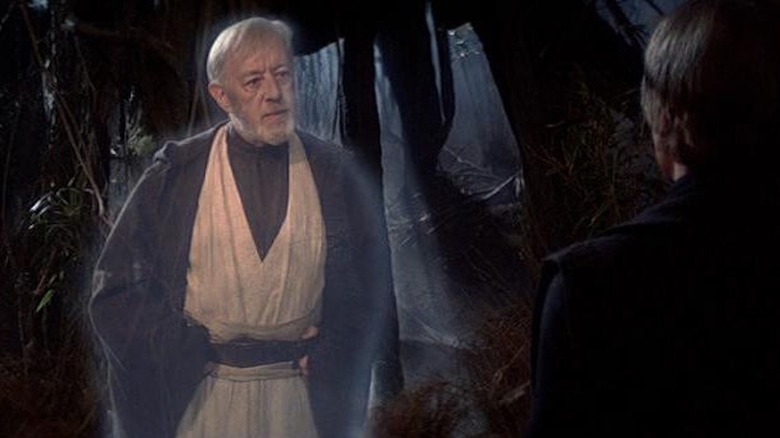How Star Wars Brought Force Ghosts To Life In The Time Before CGI
In 1977, when Darth Vader struck down Sir Alec Guinness' Obi-Wan Kenobi in "Star Wars: Episode IV – A New Hope," audiences new to the rules of this galaxy far, far away figured this was the last we'd see or hear of the old Jedi master. So when he spoke to his mentee, Luke Skywalker, in the cockpit of his X-wing fighter during his incredibly tense trench run, well, it's a wonder the young man didn't freak out and put his spacecraft into the wall like a spacebound Dale Earnhardt. I always thought the old man should've given Luke a heads-up prior to the assault on the Death Star, just to let him know he might drop by with some disembodied pointers if things got a little hairy.
In any event, this stirring moment let a legion of newly-minted "Star Wars" fans know that Jedi of Kenobi's Forceful magnitude are forever keeping an eye on their most gifted students from the afterlife. And should a Jedi find themselves in an isolated setting populated with nothing but a bunch of swamp slugs and Jubba birds, they might even pay a visit in shimmery ghost form.
This was one of many lessons Luke learned while stranded on Dagobah in "Star Wars: Episode V – The Empire Strikes Back." As with most of the optical effects pioneered or improved upon in these movies, no one balked at the look of the spectral Kenobi. We accepted it as 100% real within the world because these movies were that absorbing, and the FX work was that mindblowingly superb. But after the fifth or sixth viewing, burgeoning filmmakers and FX artists began clamoring for the magicians' secrets. And these details were freely shared in many a making-of book or magazine article.
Sir Alec on black velvet
In John Phillip Peecher's "Star Wars – The Making of 'Return of the Jedi,'" Howard Kazanjian, who produced all three Original Trilogy installments (as well as "Raiders of the Lost Ark), spilled the beans on the Force ghost process, and how it changed from "The Empire Strikes Back" to "Return of the Jedi."
For "Empire," Sir Alec was placed in front of a black velvet background, where he delivered his lines without another actor present. "The aura was then added to his image, and this film was composited together with the film of Mark," said Kazanjian. Alec wasn't a fan of this approach. As Kazanjian observed, "[I]t's awfully hard to get into the scene and deliver your lines to another actor who isn't even there." This is, of course, commonplace now in the age of CG-laden blockbusters, where characters and whole environments are added in post-production, but at the time, for the classically trained Sir Alec, this held zero appeal.
VistaVision to the rescue!
When it came time to shoot Sir Alex's scenes for "Return of the Jedi," the filmmakers made sure the legendary British actor would be able to perform on an actual set with actual people (namely Mark Hamill). This meant they had to tweak the Force ghost filming process a tad. According to Kazanjian, they did so thusly:
"In order to have Sir Alec and Mark in the same scene and still be able to add the shimmer to Ben Kenobi's image — remember, he isn't actually 'alive' in these scenes — we had to do certain shots with the VistaVision camera. The VistaVision film will give us a rock-steady image to work with later. Shooting this scene as one normally does also meant that Sir Alec couldn't touch Mark or cross in front of him, because we don't want the shimmer, when it's added, to overlap onto Mark. It's more difficult to add the shimmer in the lab, but we think that the performances will more than make up for the extra trouble."
Yes, VistaVision! The widescreen 35mm format invented by Paramount in 1954, shown off to dizzyingly gorgeous effect in Alfred Hitchcock's "Vertigo," proved incredibly helpful to the "Star Wars" FX wizards throughout the shooting of the original trilogy. Though Paramount abandoned the format in 1961, the VistaVision camera proved integral to the shooting of the series' groundbreaking optical effects. Not to be all fogeyish (but yes, to be all fogeyish), it was so much fun to get under the hood of these pre-CG movies. It might've been a pain in the tuchus to make them (George Lucas would certainly agree), but this handmade quality beats ones-and-zeroes every time.


